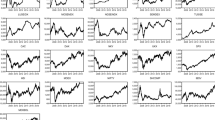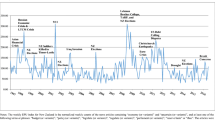Abstract
In this paper, we examine the return and volatility spillovers, together with the trend spillovers on the sectoral equity returns for Australian and New Zealand markets. We find that the return spillovers of industrial, local and global shocks have a limited effect on Australian and New Zealand sector returns, whereas the volatility spillovers play a significant role on explaining the volatility of sector equity indices. Furthermore, we discover that the volatility spillover effects of the global and industrial shocks are greater in magnitude for explaining the volatility of the Australian sectors than those of New Zealand, particularly basic materials, oil and gas, technology and telecom sectors. By employing the trend spillover model, we find that the volatility spillover effects of global sector indices have been increasing over the volatility of the Australian sectoral returns until now. This finding proposes that Australian sector equity market is more integrated with the world than the New Zealand counterpart.




Similar content being viewed by others
Notes
For a detailed survey, see Balli et al. (2013a).
In this paper, “industrial” and “sectoral” are used interchangeably. Additionally we used “global” and “world” words interchangeably as well. For the sake of brevity, when we refer the “industrial” shocks, we refer the global industrial shocks.
Level 1 is the market index which covers all the sectors in each region or countries. Level 2 divides the total market into 10 industries and covers all the sectors within each group in each region or country. Level 3–6 subdivide the level 2 classifications into sector classifications in increasing detail.
The sector indices are listed in Table 1.
However, the data for telecom, utilities, industrials and technology of New Zealand are available from 29/07/1991; 18/05/1992; 11/04/1994 and 18/06/2007 while the data for technology and telecom of Australia only available from 28/05/2001 and 17/06/1996 respectively.
Some global sector indices (oil & gas, telecom and technology) might have affected national equity returns, and may not be able to claim that 𝜖 NZ,t is a isolated local shock, therefore we use Cholesky decomposition to explore the idiosyncratic innovations of the national equity markets. After applying this decomposition, the results did not change substantially. For more the details of Cholesky decomposition, see Balli and Balli (2011).
The application of variance ratio to Australian sector equity index can be easily driven from these formulas.
Due to the political and economic integration between New Zealand and Australia, there might be some spillover effects from Australia to New Zealand. For the NZ index, indeed, the literature is pointing out. However, for sectoral indices, we have run the following model: R s,t =a s+b s R s,t−1+η NZ,t−1 R NZ,t−1+η w,t−1 R w,t−1+η GS,t−1 R GS,t−1+η A,t−1 R A,t−1+ε s,t . Different from Eq. (2), we have tested the Australia effect via R A,t−1 and 𝜖 A,t . However, after performing the models for NZ sectoral returns, we have observed that the coefficients of Australia effect are mostly insignificant. More importantly, the effect of Australia’s sectoral equity indices on the variance ratios of New Zealand sector indices is negligible.
The variance ratio results for the constant spillover and time-varying spillover models are similar, and therefore we did not post the results of variance ratios for the time-varying model.
Local shock represents the ratio of the aggregate New Zealand (Australia) equity index on the volatility of the sector equity indices, global shock represents the ratio of the aggregate world equity index on the volatility of sector’s equity indices and industrial shock represents the ratio of the global sector equity indices on the volatility of the sector equity indices. Own shock is the idiosyncratic shock of the sector indices on its own volatility, which equals 1 − (local shock+ global shock+ industrial shock)
References
Baele L (2005) Volatility spillover effects in European equity markets. J Financ Quant Anal 40:373–401
Balli F, Balli HO (2011) Sectoral equity returns in the Euro region: is there any room for reducing the portfolio risk. J Econ Bus 63(2):89–106
Balli HO, Balli F, Louis RJ (2013a) Time-varying spillover effects on sectoral equity returns. International Review of Finance 13(1):67–91
Balli F, Basher SA, Jean-Louis R (2013b) Sectoral equity returns and portfolio diversification opportunities across the GCC region. J Int Financ Mark Inst Money 25:33–48
Balli F, Balli HO, Ngoc L (2014) Diversification across ASEAN-wide sectoral and national equity returns. Ecol Model 41:398–407
Bekaert G, Harvey CR (1997) Emerging equity market volatility. J Financ Econ 43:29–77
Bekaert G, Harvey CR, Ng A (2005) Market integration and contagion. J Bus 78:39–69
Berndt ER, Hall BH, Hall RE, Hausman JA (1974) Estimation and inference in nonlinear structural models. Ann Econ Soc Meas 3:653–666
Bollerslev T (1986) Generalized autoregressive conditional heteroscedasticity. J Econ 31:307–327
Cavaglia S, Brightman C, Aked M (2000) The increasing importance of industry factors. Financial Analyst Journal September-October pp 41–54
Edwards S, Susmel R (2001) Volatility dependence And contagion In emerging equity markets. J Dev Econ 66:505–532
Engle R (1982) Autoregressive conditional heteroscedasticity with estimates of the variance of the U.K. inflation. Econometrica 50:987–1008
Engle R, Ito T, Lin W (1990) Meteor showers or heat waves?: Heteroscedasticity intra-daily volatility in the foreign exchange markets. Econometrica 58:525–542
Fedorova E, Saleem K (2009) Volatility spillovers between stock and currency markets: Evidence from emerging Eastern Europe. Czech J Econ Financ 60(6):519–533
Fratzscher M (2002) Financial market integration in Europe: on the effects of EMU on stock markets. Int J Financ Econ 7:165–193
Gupta R, Mollik AT (2008) Volatility, time varying correlation and international portfolio diversification: An empirical study of Australia and emerging markets. Int Res J Financ Econ 18:18–35
Jarque CM, Bera AK (1980) Efficient tests for normality. Econ Lett 6:255–259
Kanas A (1998) Volatility spillovers across equity markets: European evidence. Appl Financ Econ 8:245–256
Lakshmi B, Premaratneb G (2004) Volatility spillover and co-movement: Some new Evidence from singapore. Retrieved from www.nd.edu/meg/MEG2004/Bala-Lakshmi.pdf
Lin W, Engle RF, Ito T (1994) Do bulls and bears move across borders? International transmission of stock returns and volatility. Rev Financ Stud 7:507–538
Ljung GM, Box GEP (1978) On a measure of lack of fit in time-series models. Biometrika 65:297–303
Ng A (2000) Volatility spillover effects from Japan and the US to the Pacific Basin. J Int Money Financ 19:207–233
Yilmaz K (2010) Return and volatility spillovers among the East Asian equity markets. J Asian Econ 21:304–313
Author information
Authors and Affiliations
Corresponding author
Rights and permissions
About this article
Cite this article
Balli, F., Balli, H.O. & Hong, R. Spillover effects on the sectoral returns for australian and New Zealand equity markets. J Econ Finan 40, 568–589 (2016). https://doi.org/10.1007/s12197-015-9326-6
Published:
Issue Date:
DOI: https://doi.org/10.1007/s12197-015-9326-6




